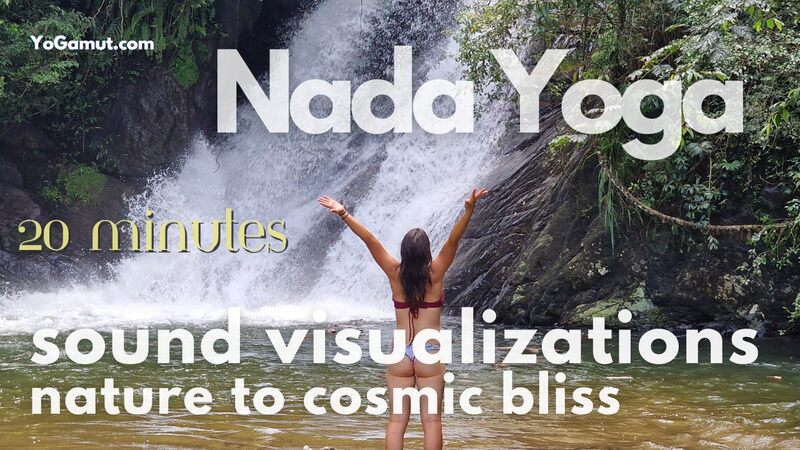
Explore the depths of Nada Yoga – Healing with sound and vibration
The ancient texts and the stages of Vaikhari, Madhyama, Pashyanta, and Paranada stages
In the hustle and bustle of our daily lives, finding moments of true serenity can seem like an elusive quest. However, there exists a profound practice that invites us to dive deep into the ocean of sound, guiding us toward inner peace and spiritual awakening. Welcome to the world of Nada Yoga, often referred to as the yoga of sound.
Nada Yoga invites us to explore the transformative power of sound vibrations and their impact on our physical, mental, and spiritual well-being. Rooted in ancient yogic traditions, this practice delves into the essence of the universe’s primordial sound, known as “Nada” or sound current.
Join us on a journey as we unravel the mysteries of Nada Yoga, discovering how the art of listening can become a pathway to self-discovery, mindfulness, and profound tranquility. In this blog post, we’ll explore the philosophy behind Nada Yoga, its historical roots, and how you can incorporate this ancient practice into your modern life.
Prepare to embark on a sonic adventure that transcends the boundaries of everyday existence and leads you to the harmonious symphony within. Are you ready to tune in to the divine melody of Nada Yoga? Let the exploration begin.
check also
> Exploring Antar Kumbhaka: The Inner Breath Retention
What is Nada Yoga?
Nada Yoga, the ancient practice rooted in the Hindu tradition, holds profound significance as the Yoga of Sound. The term “Nada” translates to sound, tone, or vibration in Sanskrit, emphasizing the central role of sound in this spiritual discipline. At its core, Nada Yoga seeks union through sound, aiming to harness the transformative power of vibrations to elevate consciousness.
In Hindu cosmology, the universe itself is believed to have originated from pure vibration, known as Nada Brahman. This cosmic sound resonates with the primordial Om mantra, and Nada Yoga endeavors to attune practitioners to this divine vibration. The practice involves turning one’s perception of hearing inward, listening for the inner spirit’s pure sound.
Throughout history, Nada Yogis, particularly masters of music like Tansen in Akbar’s court, were said to wield extraordinary powers over natural phenomena. Their music not only stirred human emotions but purportedly influenced elements such as heat, rainfall, and even induced darkness, showcasing the profound connection between sound and the fabric of reality.
While classical Indian music has embraced Nada Yoga principles, the practice itself remains one of the least documented streams of sacred sound. The inclusive nature of Nada Yoga expands beyond the audible spectrum, encompassing earthly music, the sounds of space, and the entire electromagnetic frequency spectrum. Through the practice of Nada Yoga, practitioners aim to broaden their consciousness and cultivate a deeper understanding of the interconnectedness of all vibrations.
check also
> Kundalini Yoga for Heart Chakra – Mixed Practice for Anahata
The Meaning Of Anahata, The Unstruck Sound
An essential aspect of Nada Yoga is the exploration of anahata nada, the unstruck sound. In Sanskrit, “anahata” means unstruck, signifying a sound that is not produced by any external source but resonates from within, Anahata is also the name of the Heart Chakra.
The Hatha Yoga Pradipika describes anahata nada as a mystical sound ranging from drums and flutes to the buzzing of bees and the shimmering of gongs. These sounds are said to emanate from within the sushumna, the central energy channel, and are particularly prominent in the heart chakra, also referred to as the “ear of the heart.”
To attain a perception of anahata nada, practitioners of Nada Yoga embark on advanced renunciate practices. This journey involves years of dedication to hatha yoga techniques, including pratyahara (turning off the sense organs), dharana (one-pointed concentration), and dhyana (sustaining concentration for extended periods). The purification of the sushumna nadi, where anahata is produced, is crucial and requires a dedicated pranayama practice.
While the traditional path to experiencing anahata nada may be rigorous, there exists an accessible external practice known as ahata nada yoga. This practice involves listening to external sounds, such as soft and calming music, with focused attention.
By meditating on these external sounds, practitioners can cultivate concentration and gradually tune into the subtleties of sound. The journey towards understanding anahata nada is a mystical exploration, delving into the depths of one’s inner being through the medium of sound.
How to Practice Nada Yoga
Embarking on the journey of Nada Yoga requires a thoughtful and accessible approach, especially for modern practitioners who may not dedicate years to advanced renunciate practices. While the traditional techniques outlined in the Hatha Yoga Pradipika may be challenging for many, a practical and effective entry point is through ahata nada yoga – the practice of external sound.
There are many ways to practice Nada Yoga, and you can have a look at the numerous meditation I’ve published on my channel.
Here I’ll give you a simple practice you can do without any guidance, at home or anywhere you want if you use headphones.
- Choose soft and calming music, preferably Indian classical music (but also Western Classical Music and Jazz will do – I recommend “Interstellar Space” by John Coltrane), and find a comfortable meditation pose.
- Using headphones to seal focus, practitioners can immerse themselves in the sounds, redirecting attention to the music whenever thoughts arise.
- Starting with 10-15 minutes of daily practice, individuals can gradually deepen their connection with external sounds, honing concentration and listening abilities.
As the practice progresses, practitioners may experiment with turning the volume down, challenging themselves to maintain focus even in quieter settings. This gradual refinement of listening skills contributes not only to a heightened appreciation of external music but also to an enhanced ability to quiet the mind.
Ultimately, the practice of Nada Yoga, whether through traditional methods or accessible ahata nada yoga, serves as a powerful tool for spiritual growth, offering a pathway to inner stillness through the profound exploration of sound.
Nada Yoga in the scriptures
Nada Yoga, the ancient practice of attuning oneself to the cosmic sound, finds its roots deeply embedded in various spiritual and philosophical scriptures.
Across different traditions and cultures, references to the primordial sound, also known as “Nada,” resonate within the sacred texts, offering insights into the profound significance of sound in the journey of self-realization. Here are glimpses of Nada Yoga in some of the prominent scriptures:
- Vedas:
Nada Yoga has its origins in the Vedas, the oldest scriptures of Hinduism. The Sama Veda, in particular, emphasizes the use of sound and music in spiritual practice. The concept of “Om” as the cosmic sound is prevalent, representing the essence of ultimate reality. The Upanishads, which expound upon the philosophical teachings of the Vedas, delve into the significance of Nada as a transcendent, eternal vibration. - Yoga Sutras of Patanjali:
The Yoga Sutras, attributed to the sage Patanjali, touch upon Nada Yoga in the context of the inner journey. In the Sutras, Patanjali discusses the concept of “Pranava” (the sacred syllable ‘Om’) and how the practitioner can connect with the universal sound to attain higher states of consciousness. - Bhagavad Gita:
In the Bhagavad Gita, Lord Krishna imparts spiritual wisdom to Arjuna, emphasizing the importance of inner focus and meditation. While not explicitly mentioning Nada Yoga, the Gita underscores the significance of inner listening and contemplation as essential components of the spiritual path. - Tantric Texts:
Within the Tantric tradition, various texts explore the mystical aspects of sound and vibration. The concept of “Anahata Nada,” the unstruck sound, is central to Tantric philosophy. Practitioners of Nada Yoga often work with the chakras, associating specific sounds with each energy center. - Sant Mat Tradition:
The Sant Mat tradition, which includes the teachings of saints like Kabir and Guru Nanak, places a strong emphasis on the inner experience of Nada. Practitioners in this tradition meditate on the inner sound as a means of attaining spiritual realization and connecting with the divine.
These scriptural references provide a glimpse into the rich tapestry of Nada Yoga, showcasing its universal nature and its role as a timeless practice for seekers on the path of self-discovery. As you explore Nada Yoga, remember that its wisdom transcends cultural and religious boundaries, inviting all who seek harmony and enlightenment to tune into the eternal sound within.

Stages of Nada Yoga
Let’s explore the stages of Nada Yoga in alignment with the princples of Vaikhari, Madhyama, Pashyanta, and Paranada, as expressed in the Vedas:
- Vaikhari (Audible Sound):
At the initial stage of Nada Yoga, practitioners focus on external, audible sounds. This involves developing acute awareness of the sounds in the environment, ranging from nature’s melodies to everyday noises. Vaikhari represents the struck sound that is perceivable by the human ear. - Madhyama (Mental Sound):
Advancing from the external sounds, practitioners shift their attention to the mental realm in the Madhyama stage. This involves experiencing the subtler, mental sound within the mind. It is a stage where the practitioner begins to explore the vibrational qualities of thoughts and inner mental activities, transcending the limitations of external auditory perception. - Pashyanta (Subconscious Sound):
In the Pashyanta stage, practitioners delve into the subconscious realm. This involves experiencing visual or subconscious sounds—those that are seen or felt rather than heard. Pashyanta represents a deeper level of internalization, where the practitioner explores the more subtle and hidden aspects of sound within the inner consciousness. - Paranada (Transcendent Sound):
The final stage of Nada Yoga is Paranada, where practitioners connect with the transcendent sound. This is the stage of perceiving the unstruck sound, beyond the limitations of audible or mental sounds. Paranada represents the cosmic vibration, the unmanifested sound that goes beyond the ordinary boundaries of perception. In this stage, practitioners may experience a profound sense of unity and oneness with the universal sound, transcending the individual self.
These stages of Nada Yoga, from the audible to the transcendent, guide practitioners on an inward journey, progressively deepening their connection with the vibrational essence of existence.
Each stage opens new dimensions of awareness, leading to a state of profound inner harmony and spiritual realization.




